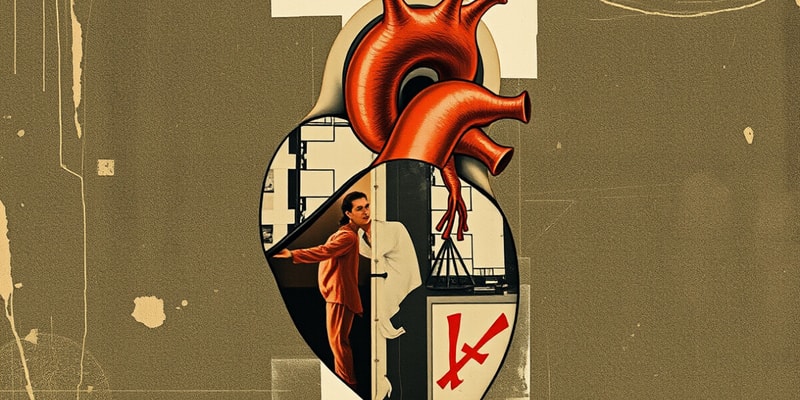Questions and Answers
Which type of heart failure is characterized by a reduced ejection fraction of less than 40%?
What is a common symptom of heart failure experienced by patients?
Which of the following conditions is NOT typically a risk factor for developing heart failure?
What is the primary purpose of using diuretics in heart failure treatment?
Signup and view all the answers
Which diagnostic tool is considered primary for assessing heart structure and function in suspected heart failure?
Signup and view all the answers
In the context of heart failure, what does HFrEF stand for?
Signup and view all the answers
Which lifestyle modification is recommended for managing heart failure?
Signup and view all the answers
What is a key feature of diastolic heart failure (HFpEF)?
Signup and view all the answers
Study Notes
Overview of Heart Failure
- A clinical syndrome where the heart cannot pump sufficient blood to meet the body's needs.
- Often results from other conditions like coronary artery disease, hypertension, or valve disorders.
Types of Heart Failure
-
Systolic Heart Failure (HFrEF):
- Characterized by reduced ejection fraction (EF < 40%).
- Heart's ability to contract is impaired.
-
Diastolic Heart Failure (HFpEF):
- Normal or preserved ejection fraction (EF ≥ 50%).
- Heart has difficulty relaxing and filling with blood.
-
Right-Sided Heart Failure:
- Often caused by left-sided failure or lung disease.
- Leads to systemic venous congestion.
-
Left-Sided Heart Failure:
- Can be further divided into:
- Left Heart Failure with Reduced EF: Decreased pumping ability.
- Left Heart Failure with Preserved EF: Impaired filling.
- Can be further divided into:
Symptoms
- Shortness of breath (dyspnea) on exertion or at rest.
- Fatigue and weakness.
- Swelling (edema) in legs, ankles, or abdomen.
- Rapid or irregular heartbeat (palpitations).
- Persistent cough or wheezing with white or pink blood-tinged phlegm.
Risk Factors
- Age (higher risk in older adults).
- Hypertension.
- Coronary artery disease.
- Diabetes.
- Obesity.
- Smoking and excessive alcohol consumption.
Diagnosis
- Patient history and physical examination.
- Blood tests (e.g., B-type natriuretic peptide levels).
- Imaging studies (e.g., chest X-ray, echocardiogram).
- ECG (electrocardiogram).
Treatment
-
Lifestyle Modifications:
- Dietary changes (low sodium diet).
- Regular physical activity.
- Weight management.
- Smoking cessation.
- Limiting alcohol intake.
-
Medications:
- ACE inhibitors or ARBs (to reduce blood pressure).
- Beta-blockers (to improve heart function).
- Diuretics (to reduce fluid buildup).
- Aldosterone antagonists.
-
Devices and Procedures:
- Implantable cardioverter-defibrillators (ICDs).
- Cardiac resynchronization therapy (CRT).
- Ventricular assist devices (VADs).
- Heart transplant in severe cases.
Prognosis
- Varies based on underlying cause and severity.
- Early detection and management can improve quality of life and outcomes.
- Regular follow-up care is essential for monitoring and adjusting treatment.
Overview of Heart Failure
- Heart failure is a clinical syndrome where the heart fails to pump enough blood to meet the body’s requirements.
- Commonly arises from conditions such as coronary artery disease, hypertension, and valve disorders.
Types of Heart Failure
-
Systolic Heart Failure (HFrEF):
- Reduced ejection fraction (EF < 40%).
- Impaired heart contraction capability.
-
Diastolic Heart Failure (HFpEF):
- Normal or preserved ejection fraction (EF ≥ 50%).
- Difficulty in heart relaxation and filling with blood.
-
Right-Sided Heart Failure:
- Often secondary to left-sided heart failure or pulmonary diseases.
- Causes systemic venous congestion.
-
Left-Sided Heart Failure:
- Divided into:
- Reduced EF: Poor pumping ability.
- Preserved EF: Impairment in heart filling.
- Divided into:
Symptoms
- Shortness of breath (dyspnea) may occur during activity or at rest.
- Patients often experience fatigue and weakness.
- Swelling (edema) typically presents in the legs, ankles, or abdomen.
- Rapid or irregular heartbeat (palpitations) is common.
- Persistent cough or wheezing may yield white or pink blood-tinged phlegm.
Risk Factors
- Age significantly increases risk, especially in older adults.
- Hypertension and coronary artery disease are prominent contributors.
- Other factors include diabetes, obesity, smoking, and excessive alcohol consumption.
Diagnosis
- Comprehensive patient history and physical examination are essential.
- Blood tests (including B-type natriuretic peptide levels) assist in assessment.
- Imaging studies like chest X-rays and echocardiograms confirm diagnosis.
- ECG (electrocardiogram) provides insights into heart rhythm and function.
Treatment
-
Lifestyle Modifications:
- Implement dietary changes such as a low-sodium diet.
- Encourage regular physical activity and weight management.
- Advise cessation of smoking and reduction of alcohol intake.
-
Medications:
- ACE inhibitors or ARBs help reduce blood pressure.
- Beta-blockers are used to enhance heart performance.
- Diuretics assist in minimizing fluid accumulation.
- Aldosterone antagonists are beneficial in treatment.
-
Devices and Procedures:
- Implantable cardioverter-defibrillators (ICDs) provide critical heart rhythm support.
- Cardiac resynchronization therapy (CRT) improves efficiency in heart contractions.
- Ventricular assist devices (VADs) serve as mechanical support for heart function.
- Heart transplantation remains an option in severe cases.
Prognosis
- Prognosis is influenced by the underlying cause and severity of heart failure.
- Early detection and timely management can significantly enhance quality of life and patient outcomes.
- Regular follow-up care is crucial for effective monitoring and adjustments to treatment plans.
Studying That Suits You
Use AI to generate personalized quizzes and flashcards to suit your learning preferences.
Description
Explore the clinical syndrome of heart failure, where the heart struggles to pump sufficient blood. Learn about the two primary types: Systolic Heart Failure (HFrEF) and Diastolic Heart Failure (HFpEF), including their characteristics and effects on the heart's function.




